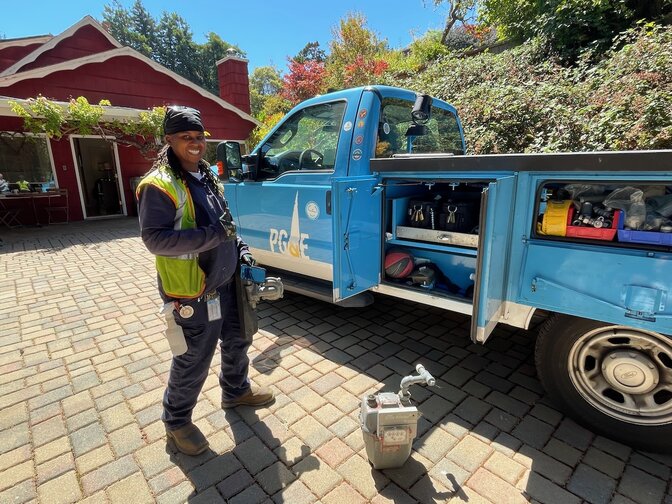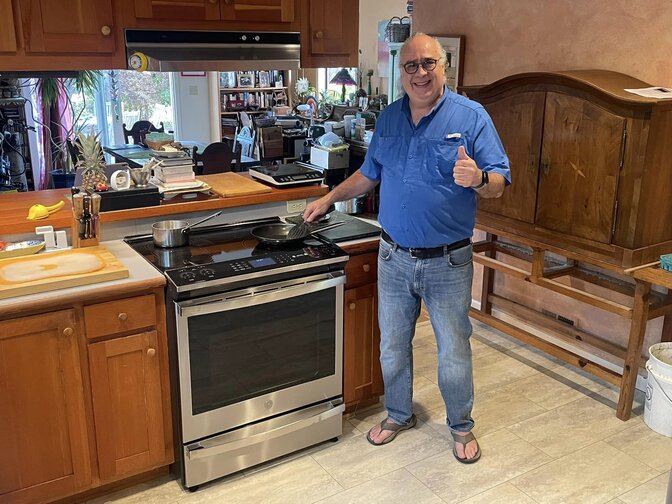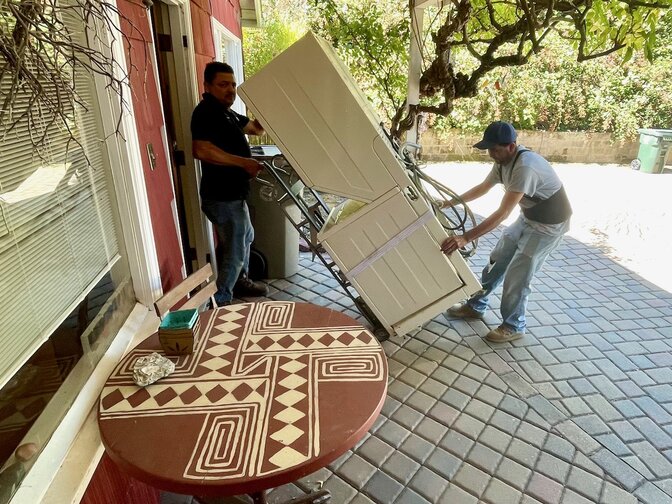In August 2024, my wife Phyllis and I finally turned off the gas on our all-electric home.
Over five years, we electrified our single-family home to save energy and money, as well as reduce our greenhouse gas emissions and help cool the earth.
First, we installed solar panels, a home battery, a heat pump water heater, and more electric appliances. In 2024, we installed three final appliances to complete our all-electric home: a new heat pump space heater, an induction range, and a clothes washer/dryer. These replaced our last gas appliances – an old furnace, stove, and clothes dryer. Check out the details for all of these products in our all-electric home document.
To cap it all off: We had our utility company turn off our gas service and remove our meter!

We were glad to replace our old gas appliances, which were emitting pollutants and contributing to climate change.
It’s a wonderful feeling to finally have healthier indoor air quality in our lives and complete the switch to clean energy.
We’ve been working towards this goal for over five years!
Now that our home is finally all-electric, our carbon footprint will be greatly reduced, and we will get much closer to achieving net-zero emissions for our household.

Here are a few key takeaways that I want to share for anyone considering a similar journey:
1. Plan ahead
This electrification took a lot of planning, as there were many tricky challenges along the way. With help from energy advisors, I put together a full electrification plan to organize this transition. This required me to analyze our energy use in great detail, but I’m glad I did. Learning how the technology works ahead of time will help you make more informed decisions, enabling you to drive the whole process. It’s worth the investment to become a knowledgeable all-electric homeowner.
2. Get advice
A good energy advisor can help you make some hard decisions that are unique to your household. Our energy advisor was HomeIntel. They prepared a helpful electrification report based on our electric utility data from Pacific Gas & Electric (PG&E). Their excellent service is free if you are a PG&E customer. Sign up here and tell James I sent you!
3. Electrify responsibly
For this project, we decided to optimize our existing 100 amp electric panel to power those new appliances – without upsizing our panel to 200 amps, which would have been costly, lengthy, and unnecessary. Our goal was to avoid an electric upgrade and reduce our load on the grid by using the Watt Diet, which helps homeowners electrify responsibly with efficient appliances and load-sharing practices. Based on our analysis, we concluded that we have sufficient capacity to power all our electric appliances with our current panel. We will use a home energy monitor to track our usage. If needed, we are open to adding a smart splitter and/or circuit pauser later on.
4. Find a good electrician
I talked to nearly a dozen electricians about this project over the years, and only a few of them seemed up-to-speed on the unique challenges of all-electric retrofits. Many tried to sell us a 200 amp upgrade, and only a few had experience installing energy monitors, smart panels, smart splitters and/or circuit pausers. (To their credit, everyone we spoke with seemed overworked, as the need for electrical services appears to be on the rise.) We ended up hiring Urban Energy for this job, as they shared our responsible electrification goals, were open to thinking outside the box, and seemed most familiar with new technology like energy monitors. The world needs more forward-thinking electricians like them! You can find a pro-electric contractor at The Switch Is On.
5. Thanks to our partners
Kudos to all the advisors and content providers who made our electrification possible: ElectrifyNow.net, GreenChange.net, HomeIntel, Marin County Sustainability Team, RedwoodEnergy.com, Resilient Neighborhoods, RewiringAmerica.com, and The Switch Is On, to name but a few. These partners and resources were invaluable in guiding us through our electrification journey.
Many thanks as well to our local contractors in Marin for taking us through the finish line:
- Appliances: Martin & Harris: martin-harris.com
- Electrical: UrbanEnergySF.com
- Heat Pumps: JohnOwensServices.com
- Plumbing: DansPlumbingandSewer.com

And special thanks to our Green Change Team and partners who chimed in with advice along the way – and who created our Action Guides and Green Tips about electrification on our GreenChange.net site.
We couldn’t have done it without all of you!
For more information on our home electrification, read my how-to article, “How We Converted Our All-Electric Home.” That article has helpful tips about each step in our journey – from initial planning to getting new appliances, and finally turning off the gas.
My hope for the future is that we can join forces to help everyone on earth electrify their lives as well so that we can all end the climate crisis. Perseverance furthers.